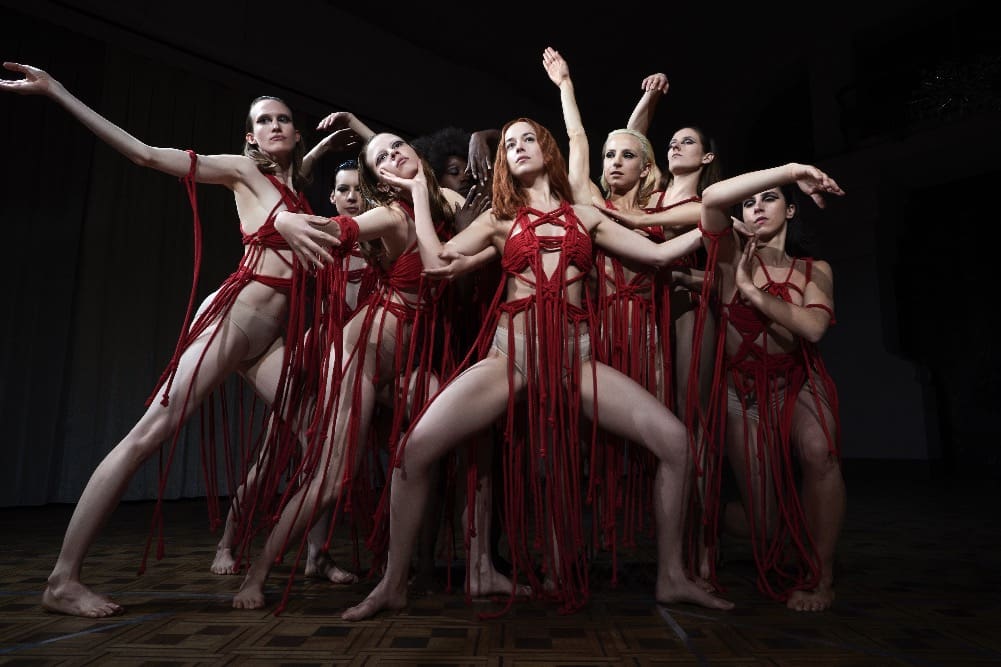
Here’s where I’ll diverge from other reviewers gleefully caught up in the hellscape that is Luca Guadagnino’s Suspiria. It’s not scary.
At least, it’s not horrific in the same sense you’d expect of a slasher, Giallo, or possession film.
Guadagnino’s reincarnation of Dario Argento’s 1977 classic of the same name is shocking in the same way mother! is and as dreadful as The Witch, but it doesn’t offer up the same supernatural thrills as its predecessor.
It’s devoid of virtually all color compared to the box of neon crayons Argento preferred, leaving room only for deep red to be spilled. By avoiding a heightened atmosphere Giallo fans crave, Guadagnino opens up new space to play with a political nightmare grounded in reality.
As concerned as the film is about following Susie (Dakota Johnson) as she rises the ranks at the renowned Helena Markos Dance Company in Berlin, it’s just as preoccupied with the violence spurred by the Red Army Faction. Coming from a sheltered life in Ohio — think Amish country — Susie looks to shed the world that held her down as a free woman, just as the RAF incites violence to cleanse Germany of its lasting Naziism.
Molotov cocktails in the streets. Witchcraft in the sheets.
The Markos coven moonlighting as a premier dance company is presented much earlier than Argento’s version as we’re introduced to this frenetic world by Markos runaway Patricia (Chloë Grace Moretz). She gasps for air with every breath, alternating language in distress as her psychologist Dr. Jozef Klemperer’s room closes in on her and the world outside catches fire.
This remains all speculation — though commonly agreed — that the psychologist is played by Tilda Swinton (not newcomer Dr. Lutz Ebersdorf) under brilliant makeup. If it is indeed Swinton, it’s an important setup for the rest of the story, diving into a world devoid of Y chromosomes.
What follows is a meta setup for the world, as the title sequence ends with a Subway station sign introducing the title. While a slight reference, it immediately informs the story of its focus on using art as a vessel for greater purpose as the Markos company does.
More specifically, how Markos and head instructor Madame Blanc (Tilda Swinton) see Susie as a rare talent on sight, leading her down a path of destruction paired with exquisite dance sequences staged by Belgian choreographer Damien Jalet. The amount of world-building and separation from Argento’s vision that scribe David Kajganich (A Bigger Splash) intends is made abundantly clear through a spectacular dance sequence cutting between Susie and an instructor trapped in a room of mirrors.
It’s a much more accomplished departure than Kajganich’s first screenplay in 2007, when he retooled Invasion of the Body Snatchers. Here, he crafts a story equally brutal and beautiful as an examination of women reclaiming their bodies and taking control over destiny from previous, rotten generations. It also seems hilariously self-aware as some moments are too haunting and gruesome, some of the actions turn into punchlines. It’s a breath of fresh air amid such vileness.
Though Susie may not seem in control as she’s being influenced by higher powers, Johnson’s performance is immensely well-restrained to match Swinton’s quiet magnitude— also the best descriptor for the film’s overall presence through its muted tones against the twisted foreground.
For all its macabre overtones, Suspiria is deliriously captured between cinematographer Sayombhu Mukdeeprom and composer Thom Yorke. The latter stepped into the job with expectations to match his Radiohead partner Johnny Greenwood’s work in film. For the most part, he succeeds, but to expect the brilliance of Greenwood’s collaborations with Paul Thomas Anderson is a losing game. Still, Yorke’s score is ultimately a palette cleanser, making the finale all the more impactful.
Similarly, Mukdeeprom’s aesthetic is deliberately dialed back as a distinction from being confused with a Giallo throwback. While the palette is dull in comparison, he and Guadagnino retool that to their advantage to create a true time capsule — full of zooms and split-focus shots — and plausibility of the coven. Moreover, the paired-down look makes Suspiria an exercise in movement and framing to incite and excite. Shots of luggage, tracking shots at waist-level, it’s all a deliberate spell.
Above all, Suspiria is a grand test in patience. Stretched to 150 minutes, it feels like an initiation test for anyone willing to stay until the debauched end. It’s not until its brazen finale where it makes good on promises told throughout the marathon.
This is not just elevated horror, it’s elevated cinema.


Comments are closed.